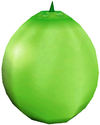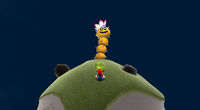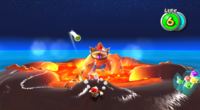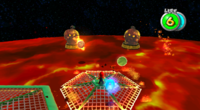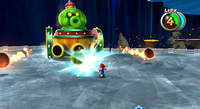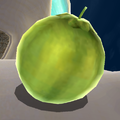Coconut
| Coconut | |
|---|---|
 Model of a coconut from Super Mario Galaxy. | |
| First appearance | Donkey Kong 3 (1983) |
| Latest appearance | Mario Party Superstars (2021) |
A coconut is a tropical fruit found in many games in the Mario franchise.
History
Donkey Kong franchise
Coconuts appear in the Donkey Kong franchise.
In Donkey Kong 3, they appear as indestructible projectiles sometimes thrown by Donkey Kong. They reappear in the game's semi-sequel, Donkey Kong 3: Dai Gyakushū.
In the Donkey Kong Country games, they are shot by Neckys and Mini-Neckys as a form of attack; Master Necky and Master Necky Sr. also spit them as their sole attack. In Donkey Kong 64, Donkey Kong uses his Coconut Shooter that fires coconuts.
Another type of coconut is the Crystal Coconut, which carries different powers depending on the media that it appears in. For example, in the Donkey Kong Country television series, the crystal coconut has healing and fortune-telling properties, whereas in Donkey Kong 64, Crystal Coconuts are a consumable source of power for the Kongs' special abilities.
Club Nintendo
"Donkey Kong in: Banana Day 24"
Coconuts also play a role in the Donkey Kong comic "Banana Day 24," published in the German magazine Club Nintendo. In this story, giant aliens connect Earth to their spaceship, pulling the planet away. As it turns out, they erroneously took Earth for a huge coconut, a fruit their species adores. They agree to return the planet back to its original position as Diddy Kong starts to give them bananas in return.
Paper Mario series
| Coconut | |
|---|---|
| Paper Mario description | A coconut from Lavalava Island. Throw it to damage 1 enemy. |
| The Thousand-Year Door description | Fruit from a tropical island. To be honest, it ain't tasty. |
Paper Mario
Coconuts appear in Paper Mario, where they are found only in certain Coconut Trees. Such trees can be found near the shores of Lavalava Island as well as in Yoshi's Village, though some of the trees drop other items. To get them from the trees, Mario can simply whack them with his current Hammer. In battle, it is used as a weapon; it can be thrown at a single enemy to deal 3 HP damage. Coconuts are used in many recipes. Mario can sell them at any shop for 1 coin. Coconuts are also mentioned in the Tattle for Stone Chomps.
Paper Mario: The Thousand-Year Door
Coconuts reappear in Paper Mario: The Thousand-Year Door. Only one Coconut Tree is found, on a small island behind the bridge scene in Keelhaul Key. Unlike in Paper Mario, it can be eaten by Mario or his partner to recover 5 HP. They are once again used in many recipes. They can be sold to shops for a varying price from 1 coin to 4 coins. Mario must give one to Flavio on Keelhaul Key to obtain a Chuckola Cola, which must be given to Admiral Bobbery in order to revive him.
Paper Mario: Color Splash
In Paper Mario: Color Splash, papercraft coconuts[1] appear hanging from the palm trees on Bloo Bay Beach. When Mario hammers a tree, it drops a coconut, which cracks open to reveal a coin.
Mario Party series
In Mario Party 3 and Mario Party Superstars, coconuts appear in the 1-vs-3 minigame Coconut Conk, where the team of three must Ground Pound coconut trees to cause coconuts to drop from them and land on the player in the barrel.
Super Mario series
Super Mario Sunshine
Coconuts also appear with various other fruit in Super Mario Sunshine at Delfino Plaza. Sometimes, they must be used as bait for a Yoshi to hatch out of its egg. If Yoshi eats one, he will turn pink and refill his juice tank, allowing him to turn enemies into pink ascending platforms. They can also be thrown by Mario. There are also tasks in the game in which if the player puts enough of them in a basket (or other fruits), they will be rewarded with a blue coin or 1-Up Mushroom.
Super Mario Galaxy
Coconuts also appear in Super Mario Galaxy. Mario can spin into them to send them flying. This is useful for defeating enemies such as Pokeynuts and prickly plants. They are also used by King Kaliente and Roctos as projectiles. When 9999 Star Bits are collected, all coconuts become watermelons.
Super Mario Galaxy 2
Coconuts reappear in Super Mario Galaxy 2. Like in its predecessor, they are used to defeat Roctos, Prince Pikante, open chests, etc. and all coconuts become watermelons after 9999 Star Bits are collected.
Paper Mario recipes
| Recipe | Result of Cooked Item | Game the Recipe is in |
|---|---|---|
| Coconut | Tasty Tonic | Paper Mario and Paper Mario: The Thousand-Year Door |
| Iced Potato + Coconut | Bland Meal | Paper Mario |
| Dried Pasta + Coconut | Bland Meal | |
| Cake Mix + Coconut | Coco Pop | |
| Red Berry + Coconut | Super Soda | |
| Blue Berry + Coconut | Super Soda | |
| Yellow Berry + Coconut | Super Soda | |
| Apple + Coconut | Super Soda | |
| Melon + Coconut | Super Soda | |
| Koopa Leaf + Coconut | Super Soda | |
| Honey Syrup + Coconut | Tasty Tonic | |
| Jammin' Jelly + Coconut | Special Shake | |
| Cake Mix + Coconut | Coco Candy | Paper Mario: The Thousand-Year Door |
| Fire Flower + Coconut | Coconut Bomb | |
| Peachy Peach + Coconut | Fresh Juice | |
| Keel Mango + Coconut | Fresh Juice | |
| Turtley Leaf + Coconut | Fresh Juice | |
| Dried Bouquet + Coconut | Space Food | |
| Fresh Pasta + Coconut | Zess Dinner | |
| Spicy Pasta + Coconut | Zess Dinner |
Gallery
Names in other languages
| Language | Name | Meaning |
|---|---|---|
| Japanese | ヤシの実[2] Yashi no Mi |
Coconut |
| Chinese | 椰子 Yēzi |
Coconut |
| Dutch | Kokosnoot |
Coconut |
| German | Kokosnuss |
Coconut |
| Italian | Noce di cocco Cocco |
Coconut |
| Korean | 코코넛 Kokoneot |
Coconut |
| Portuguese | Côco |
Coconut |
| Spanish | Coco |
Coconut |
References
- ^ Paper Mario: Color Splash internal data: \content\Graphics\DisposObject\MOBJ\MOBJ_B_Coconut.bfres.lz
- ^ "Paper Mario: The Thousand-Year Door From Japanese to English". (June 1, 2014). The Mushroom Kingdom. Retrieved February 2, 2015.
| Donkey Kong 3 | ||
|---|---|---|
| Characters | Donkey Kong • Stanley | |
| Enemies | Buzzbee • Creepy • Super Bee* • Vine Eater* • Beespy • Attacker • Kabutomushi • Butterfly | |
| Greenhouses | Blue • Gray • Yellow | |
| Other | Gallery • Staff | |

